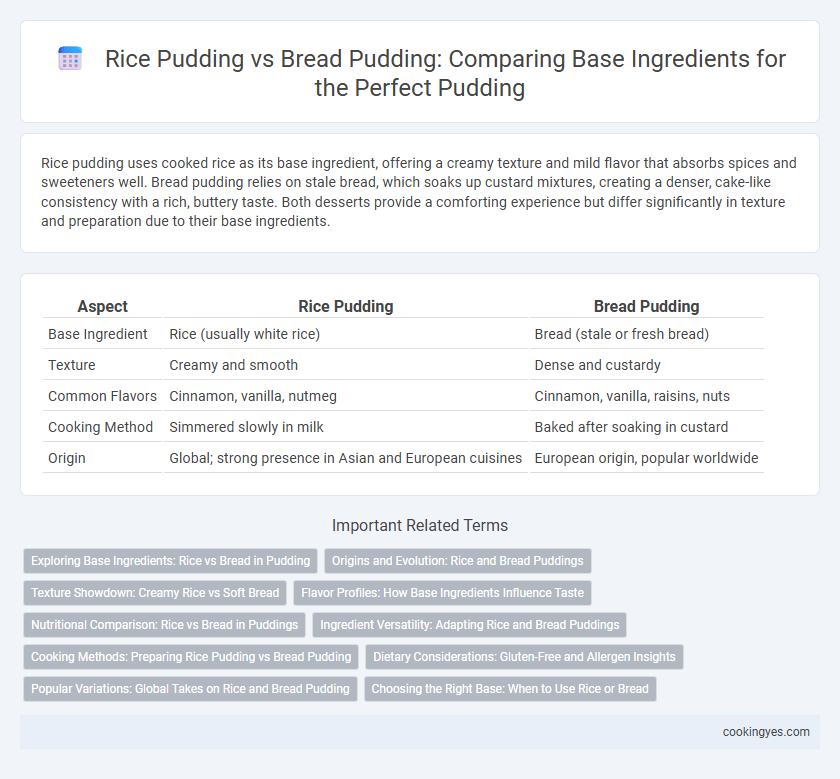Rice pudding uses cooked rice as its base ingredient, offering a creamy texture and mild flavor that absorbs spices and sweeteners well. Bread pudding relies on stale bread, which soaks up custard mixtures, creating a denser, cake-like consistency with a rich, buttery taste. Both desserts provide a comforting experience but differ significantly in texture and preparation due to their base ingredients.
Table of Comparison
| Aspect | Rice Pudding | Bread Pudding |
|---|---|---|
| Base Ingredient | Rice (usually white rice) | Bread (stale or fresh bread) |
| Texture | Creamy and smooth | Dense and custardy |
| Common Flavors | Cinnamon, vanilla, nutmeg | Cinnamon, vanilla, raisins, nuts |
| Cooking Method | Simmered slowly in milk | Baked after soaking in custard |
| Origin | Global; strong presence in Asian and European cuisines | European origin, popular worldwide |
Exploring Base Ingredients: Rice vs Bread in Pudding
Rice pudding features starchy, creamy grains that absorb milk and spices thoroughly, creating a smooth, custard-like texture rich in carbohydrates. Bread pudding utilizes stale or fresh bread that soaks up custard mixtures, offering a denser, chewy consistency with a mild flavor profile that complements eggs, sugar, and spices. Both base ingredients provide distinct textures and absorbency levels, influencing the final pudding's richness and mouthfeel.
Origins and Evolution: Rice and Bread Puddings
Rice pudding traces its origins to ancient civilizations in Asia and the Middle East, where rice was a staple grain, evolving through centuries into a sweet, creamy dessert often spiced with cinnamon and cardamom. Bread pudding emerged in Europe as a frugal, innovative way to utilize stale bread, transforming it with eggs, milk, and sugar into a warm, custardy dish reflecting local tastes and seasonal ingredients. Both puddings showcase culinary adaptability, with rice highlighting agricultural abundance and bread representing resourcefulness in historical food preservation.
Texture Showdown: Creamy Rice vs Soft Bread
Rice pudding delivers a creamy, smooth texture thanks to the tender, starchy grains that absorb milk and spices, creating a velvety mouthfeel. Bread pudding offers a soft, custardy consistency where soaked bread cubes become moist yet retain a slight chewiness, providing a heartier bite. The choice between creamy rice and soft bread ultimately hinges on whether one prefers a silky or a more substantial pudding experience.
Flavor Profiles: How Base Ingredients Influence Taste
Rice pudding offers a creamy texture with subtle, naturally sweet flavors that absorb spices like cinnamon and nutmeg, enhancing its smooth and comforting profile. Bread pudding, made from stale bread, delivers a denser, slightly chewy texture with a caramelized crust that introduces rich buttery and toasted notes. The base ingredient in each pudding distinctly shapes the overall taste experience, with rice emphasizing mild sweetness and creaminess, while bread contributes depth and a more complex, rustic flavor.
Nutritional Comparison: Rice vs Bread in Puddings
Rice pudding typically contains fewer calories and carbohydrates compared to bread pudding due to rice's lower starch density. Bread pudding, made with enriched bread, often provides higher protein and fiber content, especially if whole grain bread is used. Both puddings offer essential nutrients like calcium and vitamins, but rice pudding may be preferable for those seeking a gluten-free dessert option.
Ingredient Versatility: Adapting Rice and Bread Puddings
Rice pudding features a versatile base ingredient that absorbs a wide array of flavors, from fragrant spices like cinnamon and cardamom to tropical fruits and nuts. Bread pudding uses stale or fresh bread, making it an ideal choice for incorporating rich textures and bold flavors through custards infused with vanilla, chocolate, or dried fruits. Both puddings excel in ingredient adaptability, allowing creative variations that suit diverse taste preferences and cultural adaptations.
Cooking Methods: Preparing Rice Pudding vs Bread Pudding
Rice pudding involves simmering rice in milk or cream until the grains become tender and absorb the liquid, creating a creamy texture that often requires gentle, consistent stirring. Bread pudding preparation requires soaking bread cubes in a custard mixture made from eggs, milk, sugar, and spices, then baking until the custard sets and the top forms a golden crust. Unlike rice pudding's stovetop technique emphasizing slow cooking, bread pudding relies on oven baking to develop a firm yet moist consistency.
Dietary Considerations: Gluten-Free and Allergen Insights
Rice pudding is naturally gluten-free, making it a safer choice for individuals with celiac disease or gluten sensitivities, while bread pudding typically contains gluten due to the use of wheat bread. For those with common allergens, rice pudding can be adapted easily by using alternative milks such as almond or coconut, whereas bread pudding may require careful selection of gluten-free bread and allergen-free additives. Understanding the base ingredients' attributes helps in tailoring pudding recipes to meet dietary restrictions and allergen concerns effectively.
Popular Variations: Global Takes on Rice and Bread Pudding
Rice pudding features starchy rice grains simmered in milk or coconut milk, creating a creamy texture beloved in Indian kheer and Southeast Asian mango sticky rice. Bread pudding uses stale bread soaked in eggs, sugar, and spices, popular in British and American desserts like cinnamon bread pudding and Bananas Foster bread pudding. Both variations showcase regional ingredients and cooking techniques, reflecting diverse cultural palates from cardamom and saffron in South Asia to bourbon and pecans in the American South.
Choosing the Right Base: When to Use Rice or Bread
Choosing the right base for pudding depends on texture and flavor preferences, with rice pudding offering a creamy, soft consistency derived from starchy short-grain rice that soaks up milk and spices. Bread pudding uses stale or day-old bread, providing a denser, custard-like texture as the bread absorbs eggs, milk, and sugar, making it ideal for richer, more structured desserts. Consider rice pudding for a smooth, velvety treat and bread pudding when seeking a hearty, cake-like dessert with a custard base.
Rice pudding vs Bread pudding for base ingredient Infographic

 cookingyes.com
cookingyes.com